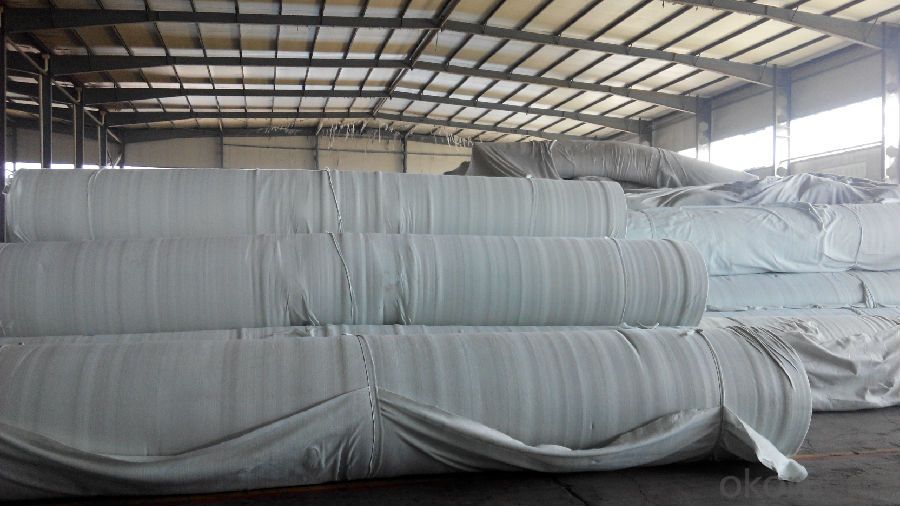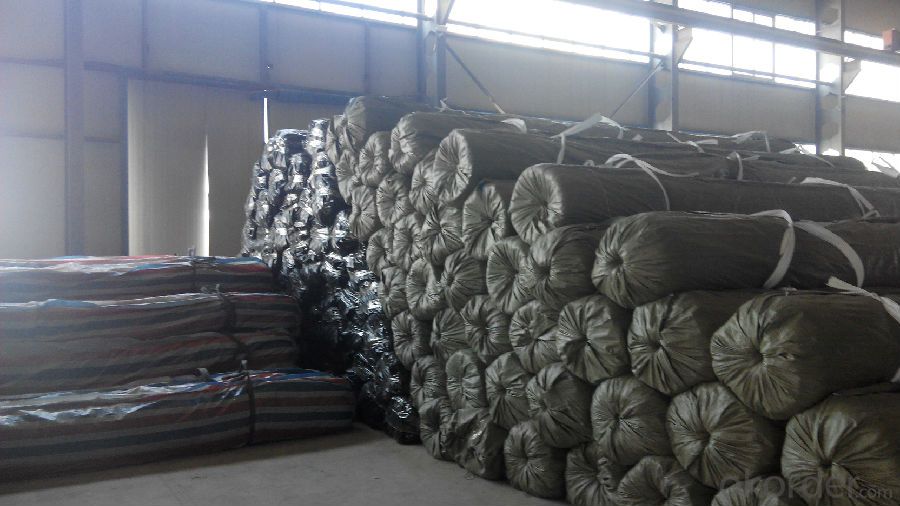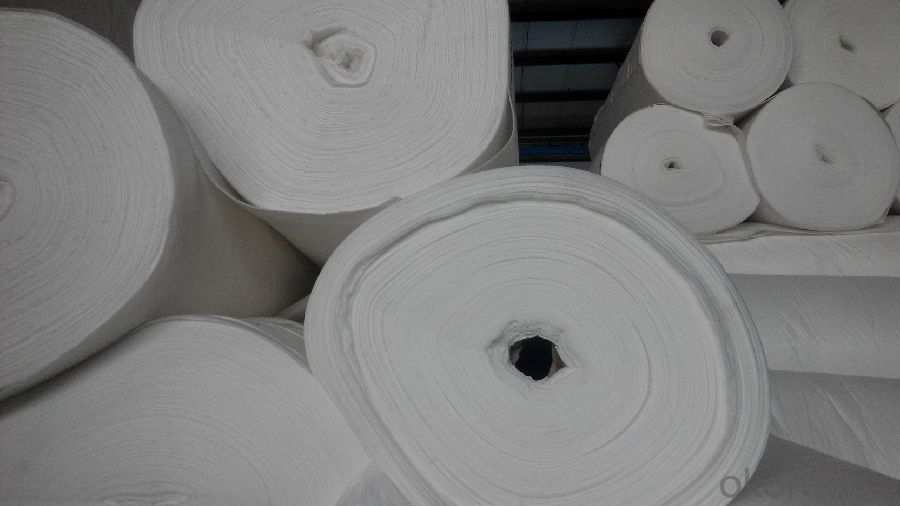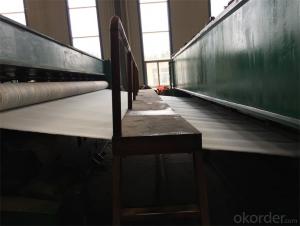PP/PET Needle Punched Non-Woven Geotextile/Non-Woven Geotextile
- Loading Port:
- Qingdao
- Payment Terms:
- TT or L/C
- Min Order Qty:
- 10000 m²
- Supply Capability:
- 100000 m²/month
OKorder Service Pledge
OKorder Financial Service
You Might Also Like
1. Non Woven Geotextile Specificatioin:
Properties | Unit | PET100 | PET150 | PET200 | PET250 | PET300 | PET350 | PET400 | PET450 | PET500 | PET600 | PET800 | |
Tensile Strength | MD | KN/m | 2.5 | 4.5 | 6.5 | 8 | 9.5 | 11 | 12.5 | 14 | 16 | 19 | 25 |
TD | KN/m | 2.5 | 4.5 | 6.5 | 8 | 9.5 | 11 | 12.5 | 14 | 16 | 19 | 25 | |
Tear Strength | MD | KN≥ | 0.08 | 0.12 | 0.16 | 0.2 | 0.24 | 0.28 | 0.33 | 0.38 | 0.42 | 0.46 | 0.6 |
TD | KN≥ | 0.08 | 0.12 | 0.16 | 0.2 | 0.24 | 0.28 | 0.33 | 0.38 | 0.42 | 0.46 | 0.6 | |
CBR Plunger Strength | KN≥ | 0.3 | 0.6 | 0.9 | 1.2 | 1.5 | 1.8 | 2.1 | 2.4 | 2.7 | 3.2 | 4 | |
Elongation at Yield | MD | % | 25-100 | ||||||||||
TD | % | 25-100 | |||||||||||
Hole Size | O90 | mm | 0.07-0.2 | ||||||||||
(O95) | |||||||||||||
Vertical Permeability | cm/s | k*(10-1~10-3),k=1.0~9.9 | |||||||||||
Identification Properties | |||||||||||||
Material | / | Polyester | |||||||||||
Color | / | White | |||||||||||
Thickness | mm, ≥ | 0.9 | 1.3 | 1.7 | 2.1 | 2.4 | 2.7 | 3.0 | 3.3 | 3.6 | 4.1 | 5.0 | |
Weight Unit Area | g/m² | 100 | 150 | 200 | 250 | 300 | 350 | 400 | 450 | 500 | 600 | 800 | |
Width | m | 1m-6m | |||||||||||
2. Non Woven Geotextile Introduction:
Nonwoven geotextiles are manufactured from the extrusion of polypropylene fibres which are then laid down on a manufacturing "bed" and then needle punched to entangle the fibres such that a dimensionally stable product is formed. Some additional thermal treatment is then applied to further improve the strength of the geotextile. Because of this manufacturing process non-woven geotextiles are generally best used in applications of drainage, filtration and protection
3. Non Woven Geotextile Features:
Wide-width rolls
Quality Certified
Proven for use in Main Roads works
Large range to suit the application
4. Non Woven Geotextile Application:
(1) artificial filling foundation movement of ground water.
(2) gravel filter layer surrounding the periphery of the drain pipe drain.
(3) in water conservancy projects wells, relief wells or inclined pipe filter.
(4) for retaining wall backfill reinforcement, or for anchored retaining wall panel.
(5) reinforced flexible pavements, crack repair roads, prevent the reflection cracks of pavement.
(6) in ternal vertical or horizontal drainage, dissipation of pore water pressure in soil.
(7) water impermeable geomembrane dam or embankment in the lower part of the back or the concrete.
(8) the isolation layer between the road ballast and subgrade, isolation layer or between the embankment and soft foundation.
(9) the isolation layer soil between highway, airport, railway ballast and artificial rockfill and soil fabric.
5. Non Woven Geotextile Product Show:



FAQ of our geotextile:
- Q: What can we do for the special customer?
A: Provide custom made service with customer's drawing; We make sure to provide you with the best solutions for your individual case. Whether standard items or non-standard items.
- Q: What can we supply?
A: We provide high levels of communication from start to finish.
- Q: What is our advantage?
A: Top Cemented Carbide has extensive business experience, Fast delivery and high quality.
Over the past decade a greater emphasis has been placed on the development and manufacturing of geosynthetic textiles. While the geosynthetics industry is comparatively new, it has already created products with applications in a wide range of industries including geotechnical, transportation, hydraulic, embankment management, and mining. In many cases, a single geosynthetic textile can solve or improve multiple civil engineering problems simultaneously.
The first example of a geosynthetic textile application is the use of a prefabricated pocket style vertical drain made from a nonwoven filter jacket specialized as a PVD filter material. The purpose of this product was to reduce the time needed for construction by quickly discharging water in the ground which speeds up the soil consolidation process. Overall, it proved to reduce construction time and speed up the consolidation of soft ground in a variety of different situations including road construction, the development of building sites, construction of gas and oil storage facilities, and bank revetment.
The second example of how geosynthetic textiles can provide solutions to civil engineering problems is the polyester woven geotextile mat. It is created from a high tenacity polyester filament which is highly dense. This particular geosynthetic textile has been used to reinforce soft ground and embankments, separate layers of sand and soft ground, prevent the uneven settlement of soft ground, and securing a safe path of travel for heavy equipment across soft ground.
- Q:Geotextile strength index with interpolation method how to calculate? Then geotextile variation, I do not quite understand, pro, if you know whether to tell me Oh! Very anxious
- Geotextile strong indicators of the interpolation method: For example: geotextile 150 grams of breaking strength is 4.5KN, geotextile 100 grams of breaking strength is 2.5KN, then the geotextile 130 grams of broken strength is how much? The calculation method is: 4.5KN-2.5KN = 2KN (that is, 50 grams of geotextile strength) 2KN by 50 grams multiplied by 30 grams is equal to 1.2KN then geotextile 130 grams of breaking strength is 3.7KN.
- Q:Geotextile pp-65-4-600 what it means
- PP plastic raw materials, chemical name: polypropylene, that is, polypropylene geotextile, a square meter of 600 grams of weight. Henkel Building Materials
- Q:What are the specifications of the garage roof using geotextiles?
- Generally with 200g or 300g, I professional production, wish smooth
- Q:Waterproof geotextile market demand prospects?
- Supply geotextile, geomembrane, composite geomembrane and other geotechnical materials. Market prospects are excellent. Geotechnical material manufacturers to answer your questions
- Q:What are the design considerations for geotextile-reinforced retaining walls?
- Some design considerations for geotextile-reinforced retaining walls include the choice of appropriate geotextile material, the proper selection and placement of reinforcement layers, consideration of the soil characteristics and potential surcharge loads, evaluation of potential water drainage and filtration requirements, and ensuring compatibility with the overall aesthetic and environmental requirements of the site.
- Q:Can geotextiles be used in geocomposite drains?
- Yes, geotextiles can be used in geocomposite drains. Geotextiles are often used as a filtration layer in geocomposite drains to prevent soil particles from clogging the drain and to allow water to pass through.
- Q:What are the specifications for geotextiles in stormwater management projects?
- The specifications for geotextiles in stormwater management projects typically include factors such as the material type, weight, tensile strength, permittivity, and flow rate. The geotextiles should be made of a durable and non-biodegradable material, capable of withstanding UV exposure and chemical exposure. The weight of the geotextile is determined based on the specific project requirements and soil conditions. Tensile strength refers to the ability of the geotextile to resist tearing or stretching under load. Permittivity measures the rate at which water can flow through the geotextile, while flow rate determines the maximum water volume that can pass through the fabric per unit of time. These specifications ensure that geotextiles effectively filter and separate soil particles from stormwater, preventing clogging and maintaining the integrity of stormwater management systems.
- Q:How do geotextiles help in preventing soil liquefaction?
- Geotextiles help in preventing soil liquefaction by providing stability and reinforcement to the soil. They act as a barrier and restrict the movement of soil particles, thereby reducing the potential for liquefaction. Additionally, geotextiles enhance the drainage capacity of the soil, allowing water to flow through and preventing the buildup of excess pore pressure, which is a major factor leading to liquefaction.
- Q:What is the latest price of geotextile?
- Ask the geotextile price is too general, because the standard too much. Short wire, filament, polyester; non-standard, GB and so on. Ton price is generally between 4900-7500 yuan / ton, but the weight <200g, an increase of 100 yuan / ton; weight> 800g, an increase of 500 yuan / ton.
- Q:Can geotextiles be used in underground storage tank applications?
- Yes, geotextiles can be used in underground storage tank applications. Geotextiles are commonly used as a protective barrier to prevent soil erosion and provide stability to the surrounding soil. In the case of underground storage tanks, geotextiles can be used to reinforce the ground and provide an added layer of protection against potential leaks or contamination.
1. Manufacturer Overview |
|
|---|---|
| Location | Taian City,Shandong Province,China |
| Year Established | 2008 |
| Annual Output Value | Above US$100 Million |
| Main Markets | Africa, Oceania, North America, Western Europe, Eastern Asia |
| Company Certifications | ISO9001;IS014001 Certificate |
2. Manufacturer Certificates |
|
|---|---|
| a) Certification Name | |
| Range | |
| Reference | |
| Validity Period | |
3. Manufacturer Capability |
|
|---|---|
| a)Trade Capacity | |
| Nearest Port | Qingdao Port;Tianjing Port;Shanghai Port |
| Export Percentage | |
| No.of Employees in Trade Department | 21-30 People |
| Language Spoken: | English; Chinese; |
| b)Factory Information | |
| Factory Size: | 10,000-30,000 square meters |
| No. of Production Lines | Above 10 |
| Contract Manufacturing | Geotechnical Material (Geogrid,Fiberglass/Polyester Geogrid,Geocell,Geonet and Geomat,Plastic Safety Fence) |
| Product Price Range | Average |
Send your message to us
PP/PET Needle Punched Non-Woven Geotextile/Non-Woven Geotextile
- Loading Port:
- Qingdao
- Payment Terms:
- TT or L/C
- Min Order Qty:
- 10000 m²
- Supply Capability:
- 100000 m²/month
OKorder Service Pledge
OKorder Financial Service
Similar products
New products
Hot products
Related keywords
































